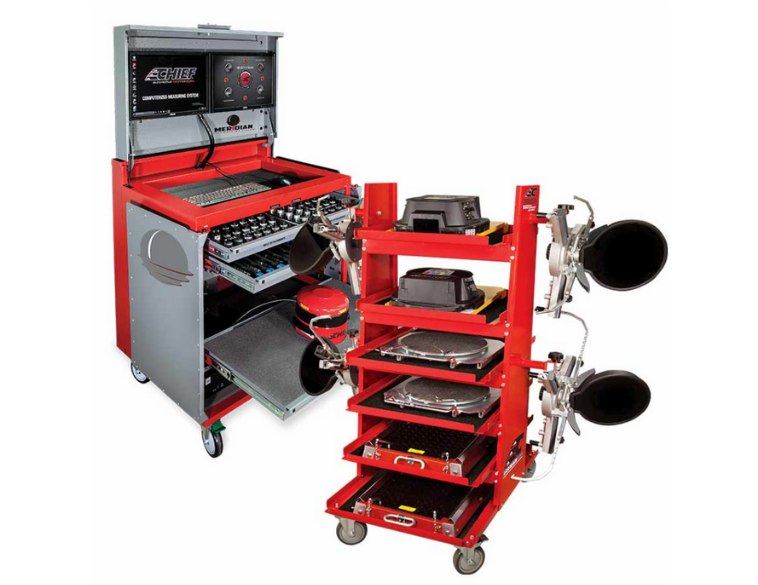Accuracy is key when it comes to pre and post measuring repairs.
During a collision, most modern vehicles are designed to crumple in a certain way, absorbing the impact to protect the occupants at all costs. Even if the damage appears minor on the surface, chances are it will be far more extensive underneath.
Mike Croker, Global Repair and Training Product Manager at Chief Collision Technology, says that when a damaged late-model vehicle is brought into a shop, the technician is sometimes at a disadvantage.
“The OEMs build vehicles to absorb collision damage in a certain way and they predict where the damage is going to go. As a technician, however, you don’t know that, so it is critical to measure the entire vehicle, even if it was just hit at the front or the rear.”
Don’t cut corners
Whether it’s a unibody or even a full-framed vehicle such as a full-size pickup, van or SUV, today, Croker says you simply can’t afford to cut corners when it comes to measuring.
“We see it every day when talking with technicians. They think that not hanging a few more measuring targets on the vehicle is going to save them time. In reality, it will take maybe 30 seconds and the result is a much better-quality repair.”
He likens the concept of just using a couple of mapping points versus the entire vehicle like comparing a polaroid camera to a high-quality video recording. “With the latter, you can pause, fast forward, rewind and analyze every single point on the vehicle,” he says.
In terms of mapping the damage points on the vehicle, Croker refers to the process as “Blueprinting.” Today he says, measuring technology allows a technician to place a vehicle on the lift and accurately map it within just five minutes.
At CSN Dundas Valley, General Manager Neil DeNardis notes that when it comes to measuring, both pre and post-repair measuring are essential as is flexibility when performing these tasks.
CSN Dundas uses Spanesi’s Touch electronic measuring system. “It can measure the vehicle’s underbody, upper body, suspension, mechanical, and bodyside openings,” he says. DeNardis also notes that the value of mobility within the shop cannot be understated when it comes to measuring vehicles.
“The measuring system should be able to measure a car or truck on a structural bench, frame rack, two-post lift, or even while sitting on the ground,” he says.
Accuracy
Besides efficiency and flexibility, a high degree of accuracy is also essential when measuring damage on late-model vehicles. Today, panel gaps and tolerances are so precise, that even a very slight misalignment can have major ramifications. That’s why technicians need to ensure that vehicle dismantling is performed thoroughly.
Mike Croker says that accurate measuring helps technicians in not only creating a proper repair plan but also identifying problems with sensors and the vehicle’s ADAS systems as well as hidden and structural damage.
“Knowing where those sensors are and if they are damaged before doing structural repairs, will save a ton of time on the back end,” Croker explains. He says he’s seen cases where this wasn’t done properly before the repair and the vehicle is “completed” only to discover that calibrations are off and it has to be torn down again, wasting valuable time and money for the shop.
At CSN Dundas Valley, Neil DeNardis, notes that not only is it important to identify where the sensors are but also ensure 100 percent accuracy when measuring since ADAS systems do not allow for any margin of error.
“With the tolerances required for vehicles with ADAS systems, we must ensure that the structural measurements are 100% accurate,” he says.
Pre and post-scanning
Today, nearly all collision centres have adopted mandatory pre and post scanning of vehicles. If you’re not performing pre-repair and post-repair diagnostic scans, you’re opening yourself to liability issues,” says DeNardis.
Therefore, when it comes to measuring and identifying damage, technicians need to consider the “electronic integrity” of the vehicle as much as its structural integrity.
Besides identifying any sensors, radar, camera, and other electronic systems on the vehicle and replacing them where necessary, the shop needs to ensure they are located in the correct position as required by the OEM every single time.
DeNardis says that CSN Dundas Valley makes sure to factor in scan and calibration times “into our repair plans, and we make every attempt to identify as much damage upfront as possible.”
Besides accuracy, the long-term benefits resulting from accurate measuring are significant. J.R. Martino, General Manager and Managing Partner at Budds’ Collision Services, says that by investing in advanced measuring systems today, shops can see greater profits and more work from insurance partners.
“Accurate measuring lowers the risk of supplements; reduces cycle time and reduces the length of rental,” he says. The result is not only a better and safer repair, but more satisfied customers and insurance partners, resulting in a better reputation and future business opportunities for the shop.



